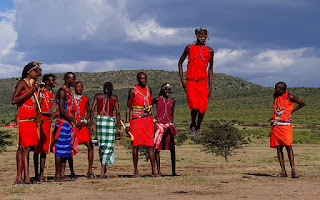Maasai Tribe Oral History and Music
Though accounts of history are usually provided through written accounts, much can also be learned through non-written records. For examples of the importance of non-written records, one can look to the Maasai tribe. The Maasais are a group of tribal people living in Kenya and Tanzania. (1) The Maasais' ancestors or believed to have originally lived in North Africa, However, they steadily made their way south along the Nile Valley and settled in Northern Kenya in the fifteenth century. (2) |
| People of the Maasai tribe in Kenya https://commons.wikimedia.org/wiki/File:Maasai_tribe.jpg |
As an active tribal group in modern-day Kenya, the Maasais cling to their traditional way of life. A lot of their traditions are centered around oral narrations such as folktales, songs, stories, poetry, and chants. Much of their culture and history is told through these means of oral communication, rather than written. This communication recalls vital information such as the Maasais' knowledge of traditional medicine, grazing customs. landscape ecology, livestock management, and the harvesting of wild plant foods. (3) Their oral communication is imperative to their way of life.
One ritual of the Maasai worth looking at is the aduma, the "jumping dance" performed during the coming of age ceremonies of young warriors. The men jump straight up in the air while attempting to uphold upright posture. This dance also plays a part in how young warriors find a wife. (4) Though the dance does not specifically outline the history of the tribe, it is a means of keeping the culture and history of the Maasai alive. Here is a link to watch the aduma.
 |
| Maasai men performing the aduma. https://commons.wikimedia.org/wiki/Category:Maasai_dance#/media/File:Mara-Young-Men-Jumping-2012.JPG |
The Kenyan Flag
The flag of Kenya is another great example of a non-written record of history. Its colors and illustrations bear significant meanings. The black stripe symbolizes the people of Kenya and the green, the scenery and natural wealth of the nation. The red stripe, however, represents something much deeper. This stripe represents the blood of the people shed during their fight for independence. (5)
During the mid-1900s, the Mau Mau rebellion broke out against British rule in Kenya. (6) During the fight for independence, over 4,000 Kenyans were killed. (7) Though they were ultimately crushed during the rebellion, the people of Kenya were finally able to gain their independence through the Kenya Independence Act of 1963. (8)
Finally, the Maasai shield and two spears centered on the flag represent the protection of all the afore mentioned symbols.
One can see that the flag of Kenya represents a huge part of their history. Written words are not always needed to remind a group of people about parts of their past. This is why non-written forms of historical records are just as important as written ones.
 |
| Flag of Kenya https://commons.wikimedia.org/wiki/File:Flag_of_Kenya_(WFB_2004).gif |
(1) "The Maasai Tribe", http://www.kenya-information-guide.com/maasai-tribe.html, ¶ 4.
(2) "The Maasai Tribe", History of the Maasai Tribe, http://www.kenya-information-guide.com/maasai-tribe.html, ¶ 1.
(3) "History of the Maasai", http://www.kitumusote.org/history, ¶ 1.
(4) "Maasai People", Music and Dance, https://en.wikipedia.org/wiki/Maasai_people#Music_and_dance ¶ 5.
(5) "Flag of Kenya", Symbolism, https://en.wikipedia.org/wiki/Flag_of_Kenya ¶ 1.
(6) "Kenya", Mau Mau Uprising (1952–1959), https://en.wikipedia.org/wiki/Kenya#Mau_Mau_Uprising_.281952.E2.80.931959.29, ¶ 1.
(7) Kenya", Mau Mau Uprising (1952–1959), https://en.wikipedia.org/wiki/Kenya#Mau_Mau_Uprising_.281952.E2.80.931959.29, ¶ 2.
(8) "Kenya", Independent Kenya (1963), ¶ 1.
No comments:
Post a Comment
Note: Only a member of this blog may post a comment.